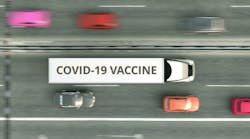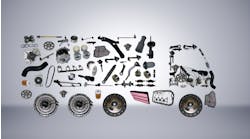After months of preparation, followed by the U.S. Food and Drug Administration’s (FDA) Dec. 11 approval of emergency use authorization (EUA) for the Pfizer-BioNTech COVID-19 vaccine, the first shipments of vaccines are making their way to dosing centers in the U.S.
A convoy of FedEx, UPS, and Boyle Transportation trucks loaded with the first doses of the vaccine rolled out of a Pfizer manufacturing plant parking lot in Michigan early Sunday morning, according to a Detroit Free Press report. Led and followed by unmarked police vehicles, the trucks carrying dry ice-cooled packages of vaccine headed to airports and distribution centers as part of Operation Warp Speed.
Delivery jets then carried the shipments to UPS and FedEx’s respective cargo hubs in Louisville, Ky., and Memphis, Tenn., for distribution on planes and trucks to the first 145 of 636 vaccine-staging areas across the country, according to Reuters. Second and third waves of vaccine shipments are scheduled to deploy to the remaining sites on Dec. 15 and 16.
Based on current projections, Pfizer’s and BioNTech’s combined manufacturing network has the potential to supply up to 50 million vaccine doses globally in 2020 and up to 1.3 billion doses by the end of 2021, Pfizer stated. Pfizer is leveraging three of its U.S. manufacturing sites to produce the COVID-19 vaccine – St. Louis, Mo.; Andover, Mass.; and Kalamazoo, Mich. Pfizer’s Pleasant Prairie, Wis., and Puurs, Belgium, sites are also being used.
For those 16 and older, the vaccine is authorized under the FDA's EUA while Pfizer and BioNTech gather additional data and prepare to file a planned Biologics License Application with the FDA for a possible full regulatory approval in 2021.
Shipments of the vaccine must remain temperature-controlled, maintaining recommended storage conditions of -70 degrees C (±10 degrees C) for extended periods of time with dry ice. Each carrier contains a GPS-enabled thermal sensor to track the location and temperature of each vaccine shipment 24-7. Once thawed, the vaccine vial can be stored safely for up to five days at refrigerated conditions.
“This is among the most important work in the history of our company, and we’re honored to be a part of the effort to help end this pandemic,” Raj Subramaniam, president and CEO of FedEx Corp., said in a statement. “I am immensely proud of our dedicated team members who continue to go above and beyond to help ensure the safe movement of these critical COVID-19 vaccines, especially during our busiest holiday shipping season to date.”
FedEx said its network of temperature-control solutions and near real-time monitoring capabilities is “well-positioned to handle COVID-19 vaccine shipments around the world.”
Since the onset of the COVID-19 pandemic, FedEx has delivered more than 55 kilotons of personal protective equipment, including more than two billion face masks, and more than 9,600 humanitarian aid shipments around the globe, Don Colleran, president and CEO of FedEx Express, pointed out. In addition, to help reach underserved communities with the COVID-19 vaccine, FedEx said it has committed $4 million in cash and in-kind transportation support to several nonprofits serving communities in the U.S. and around the world. These include Direct Relief, International Medical Corps, and Heart to Heart International.
UPS said it will move the vaccine within the first days to states designated by Pfizer and based on orders received by Operation Warp Speed and U.S. Centers for Disease Control officials.
“This is the moment of truth we’ve been waiting for at UPS,” Wes Wheeler, president of UPS Healthcare, said in a statement. “We have spent months strategizing with Operation Warp Speed officials and our healthcare customers on efficient vaccine logistics, and the time has arrived to put the plan into action.”
Pfizer-BioNTech COVID-19 vaccines originated from storage sites in Michigan and Wisconsin. Vaccines were then transported to UPS Worldport facilities in Louisville, where they were expedited Next Day Air to select destinations, including hospitals, clinics, and other medical facilities, to inoculate healthcare workers.




